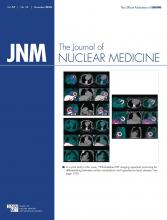REPLY: With great interest we have read the letter of Garin and colleagues, who question our study results showing only a moderate correlation between pretherapeutic 99mTc-MAA SPECT findings and distribution of 90Y-SIR-spheres in more than 500 patients (1). Obviously, the assumption that a high 99mTc-MAA uptake is followed by a high 90Y-microsphere uptake, which translates into a high dose to the tumor and, therefore, a good response to radioembolization, sounds straightforward and striking. However, obvious assumptions also have to be proven, even more so as biology has taught us that the least tumor-related issues follow simple mechanistic correlations. Garin et al. cite 3 studies and 1 review that reported contradicting results in terms of a good correlation between 99mTc-MAA uptake and treatment response (2–5). However, most studies suggesting a good correlation between 99mTc-MAA SPECT and bremsstrahlung SPECT are dealing with hepatocellular carcinoma (HCC), which is different from secondary liver tumors in some aspects. Most cases of HCC are highly perfused, have distinct tumor-feeding arteries, and are either solitary or oligometastatic. These properties might account for the reported higher correlations in our view. Indeed, pretherapeutic angiography in HCC is often done in a selective fashion with injection of 99mTc-MAA into tumor-feeding arteries and not into the right and left hepatic arteries, as done in most secondary liver tumors because of the disseminated distribution of lesions. Injection of both 99mTc-MAA and microspheres mainly into tumor-feeding arteries makes discrepancies between 99mTc-MAA and microsphere distribution less likely. Consequently, in our study the correlation of 99mTc-MAA and microsphere uptake was markedly higher in HCC (r = 0.398, P < 0.001) than in secondary liver tumors such as metastases from colorectal cancer (r = 0.22, P < 0,001), breast cancer (r = 0.308, P = 0.001), and neuroendocrine tumors (r = 0.197, P = 0.008) (1). The lower correlation between 99mTc-MAA and microsphere uptake in non-HCC liver tumors is supported by several studies, partly with high numbers of included patients. Ulrich et al. found no significant correlation between response and 99mTc-MAA uptake in 66 patients with colorectal liver metastases (6). Also, Wondergem et al. reported significant differences in 99mTc-MAA and microsphere uptake (7). Finally, our group has reported in another study that cholangiocellular carcinomas with a high 99mTc-MAA uptake did not differ from those with low uptake in terms of survival (8). Cholangiocellular carcinomas with a high 99mTc-MAA uptake even showed a trend toward shorter survival (51 wk) than those with low uptake (median survival not reached). Similar results were reported by two other studies (9,10). These findings underline the complexity of tumor biology. The delivered tumor dose seems to be only a single factor in the prognosis of patients treated with radioembolization; not considering other important factors influencing the prognosis of tumors means significantly ignoring the complexity of cancer. Neoangiogenesis is a definite hallmark of cancer aggressiveness and prognosis (11,12) that might outweigh even the higher achievable dose in those tumors.
A second important issue related to the discrepant results reported in several studies is the kind of microsphere used. Although glass microspheres do not have a relevant embolizing effect, resin microspheres—because of the much higher number of injected particles—are embolizing a significant part of the vessels in the treated part of the liver, and therefore, the blood flow is changing over time. In a significant proportion of patients—up to 20%—the treatment even has to be stopped prematurely because of treatment-induced stasis (13). Of course, this embolizing effect is likely to change the blood flow and sphere distribution over time.
Garin et al. (3) have identified differences between diagnostic and therapeutic angiography such as catheter position and vasospasm as a probable reason for the reported low correlation. Most angiographies in our study were performed by the same experienced interventional radiologist, who has more than 20 y of experience. Therefore, differences in the catheter position cannot be ruled out with certainty but seem quite unlikely and cannot be considered a major confounding issue. This is also supported by the results of Ulrich et al., who did not find any correlation between catheter position, 99mTc-MAA uptake, and therapy response (6). Second, we experienced only a very limited number of vasospasms during angiography. We did coil embolization of aberrant vessels in only a limited proportion of patients and only during therapeutic angiography (14); therefore, vasospasms caused by prolonged diagnostic angiographies cannot explain the low 99mTc-MAA uptake and higher microsphere uptake as proposed by Garin et al. Furthermore, in most cases 1–3 wk elapse between diagnostic and therapeutic angiography. Considering the highly dynamic biology of cancer, it is not likely that tumor perfusion stays stable over time, and this instability is also a factor impairing the comparability of 99mTc-MAA and microsphere uptake.
In conclusion, our study, with—up to now—by far the highest number of included patients, showed a significant but moderate correlation between 99mTc-MAA and microsphere uptake in various tumor entities. Despite the fact that many factors can, of course, influence the respective tumor uptake, because of the high number of reported patients the results have to be registered as evidence that 99mTc-MAA is not a good indicator of the distribution of resin microspheres. These results, however, should not impair the clinical value and relevance of 99mTc-MAA scintigraphy before radioembolization, particularly with regard to identification of aberrant vessels and high liver–lung shunting.
Footnotes
Published online Jun. 30, 2016.
- © 2016 by the Society of Nuclear Medicine and Molecular Imaging, Inc.







